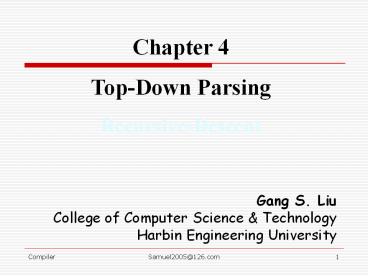Top-Down Parsing - PowerPoint PPT Presentation
1 / 12
Title: Top-Down Parsing
1
Chapter 4 Top-Down Parsing Recursive-Descent
Gang S. Liu College of Computer Science
Technology Harbin Engineering University
2
Top-down Parsing
- A top-down parsing algorithm parses an input
string of tokens by tracing out the steps in a
leftmost derivation. - The traversal of the parse tree occurs from the
root to the leaves. - Two forms of top-down parsing
- Predictive parsers.
- Attempts to predict the next construction in the
input string using one or more lookahead tokens. - Backtracking parsers.
- Tries different possibilities for a parse of the
input, backing up an arbitrary amount in the
input. May require exponential time
3
Examples
(1) exp gt exp op exp (2) gt number op
exp (3) gt number exp (4) gt
number number
exp exp
op exp number
number
1
2
3
4
Leftmost derivation
Preorder numbering
- (1) exp gt exp op exp
- (2) gt exp op number
- gt exp number
- gt number number
exp exp
op exp number
number
1
4
3
2
Rightmost derivation
The reverse of a Postorder numbering
4
Two Kinds of Top-Down Parsing
- Recursive-descent parsing
- Versatile
- Suitable for handwritten parser
- LL(1) parsing
- No longer often used
- Simple scheme with explicit stack
- Prelude for more powerful and complex bottom-up
algorithms - First L the input is processed from left to
right - Second L leftmost derivation
- 1 one lookahead symbol
5
Recursive-Descent
- The grammar rule for a nonterminal A is viewed as
a definition for a procedure that will recognize
an A.
factor() switch token case( match(()
exp() match())
break case number
match(number) break
default error
exp ? exp addop term term addop ? - term ?
term mulop factor factor mulop ? factor ?
(exp) number
match(expToken) if token expToken then
getToken() else error endif
match matches the current token with its
parameter, advances the input if it succeeds.
6
Choice
statement ? if-stmt other if-stmt ? if (exp)
statement else statement exp ? 0 1
- ifStmt()
- match(if)
- match (()
- exp()
- match())
- statement()
- if token else then
- match (else)
- statement()
- end if
EBNF is designed to mirror closely the actual
code for recursive-descent parser.
7
Repetition
- Left recursive grammar
- A A a ß
- Equivalent to ß a
- exp ? exp addop term term
- exp ? term addop term
exp() term() while token or token -
do match (token) term() end
while
8
Reporting Errors
- At a minimum, any parser must indicate that some
error exists, if a program contains a syntax
error. - Usually, a parser will attempt to give a
meaningful error message and determine the
location where that error has occurred. - Some parsers may attempt some form of error
correction.
9
General Principles
- A parser should determine that an error has
occurred as soon as possible. - The parser must pick a place to resume the parse.
- A parser must try to parse as much of the code as
possible. - A parser should try to avoid the error cascade
problem. - A parser must avoid infinite loops an errors.
10
Panic Mode
- A standard form of error recovery in
recursive-descent parsers is called panic mode. - The basic mechanism - a set of synchronizing
tokens. - Tokens may be added to the set as parsing
proceeds. - If error is encountered, the parser scans ahead
until it sees one of the synchronizing tokens.
Then parsing is resumed. - Error cascades are avoided.
- What tokens to add to the set?
- Symbols like semicolons, commas, parentheses
11
Problems with Recursive-Descent
- It may be difficult to convert a grammar into
EBNF. - It may be difficult to distinguish two or more
grammar rule options A ? a ß, if both a and ß
begin with nonterminals. - (First set)
- 3. A ? e. It may be necessary to know what token
can come after the nonterminal A. - (Follow set)
12
Homework
- 4.2 Given the grammar A ? ( A ) A e , write
pseudocode to parse this grammar by
recursive-descent. - 4.3 Given the grammar
- Write pseudocode to parse this grammar by
recursive-descent.
statement ? assign-stmt call-stmt
other assign-stmt ? identifier exp call-stmt ?
identifier ( exp-list )































